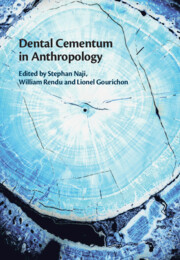Book contents
- Dental Cementum in Anthropology
- Dental Cementum in Anthropology
- Copyright page
- Dedication
- Contents
- Contributors
- Foreword
- Introduction: Cementochronology in Chronobiology
- Part I The Biology of Cementum
- 1 A Brief History of Cemental Annuli Research, with Emphasis upon Anthropological Applications
- 2 Development and Structure of Cementum
- 3 Insights into Cementogenesis from Human Disease and Genetically Engineered Mouse Models
- 4 A Comparative Genetic Analysis of Acellular Cementum
- 5 Pattern of Human Cementum Deposition with a Special Emphasis on Hypercementosis
- 6 Recent Advances on Acellular Cementum Increments Composition Using Synchrotron X-Radiation
- 7 Incremental Elemental Distribution in Chimpanzee Cellular Cementum: Insights from Synchrotron X-Ray Fluorescence and Implications for Life-History Inferences
- 8 Identifying Life-History Events in Dental Cementum: A Literature Review
- Part II Protocols
- Part III Applications
- Index
- Plate Section (PDF Only)
- References
3 - Insights into Cementogenesis from Human Disease and Genetically Engineered Mouse Models
from Part I - The Biology of Cementum
Published online by Cambridge University Press: 20 January 2022
- Dental Cementum in Anthropology
- Dental Cementum in Anthropology
- Copyright page
- Dedication
- Contents
- Contributors
- Foreword
- Introduction: Cementochronology in Chronobiology
- Part I The Biology of Cementum
- 1 A Brief History of Cemental Annuli Research, with Emphasis upon Anthropological Applications
- 2 Development and Structure of Cementum
- 3 Insights into Cementogenesis from Human Disease and Genetically Engineered Mouse Models
- 4 A Comparative Genetic Analysis of Acellular Cementum
- 5 Pattern of Human Cementum Deposition with a Special Emphasis on Hypercementosis
- 6 Recent Advances on Acellular Cementum Increments Composition Using Synchrotron X-Radiation
- 7 Incremental Elemental Distribution in Chimpanzee Cellular Cementum: Insights from Synchrotron X-Ray Fluorescence and Implications for Life-History Inferences
- 8 Identifying Life-History Events in Dental Cementum: A Literature Review
- Part II Protocols
- Part III Applications
- Index
- Plate Section (PDF Only)
- References
Summary
Acellular cementum (AC) is critical for dental attachment and periodontal function. This chapter emphasizes how insights into cementum's nature have increased through human disease and experimental animal models. X-linked hypophosphatemia (XLH) is the most common form of hereditary rickets, in which low circulating phosphate and altered vitamin D metabolism are associated with skeletal and dental mineralization defects. AC thickness is reduced in XLH, and periodontal function may be affected. Inorganic pyrophosphate is a circulating inhibitor of mineralization. The inherited disorder, hypophosphatasia (HPP), is characterized by increased pyrophosphate levels, leading to skeletal and dental hypomineralization. AC is mainly affected by HPP, and premature loss of deciduous and permanent teeth is a common result. Conversely, a decrease in pyrophosphate results in increased cementum thickness. Extracellular matrix proteins also regulate cementum formation. Bone sialoprotein (BSP) is a component of cementum. Deletion of BSP in genetically edited mice results in reduced or absent AC, leading to periodontal destruction.
Keywords
- Type
- Chapter
- Information
- Dental Cementum in Anthropology , pp. 65 - 82Publisher: Cambridge University PressPrint publication year: 2022
References
- 2
- Cited by



